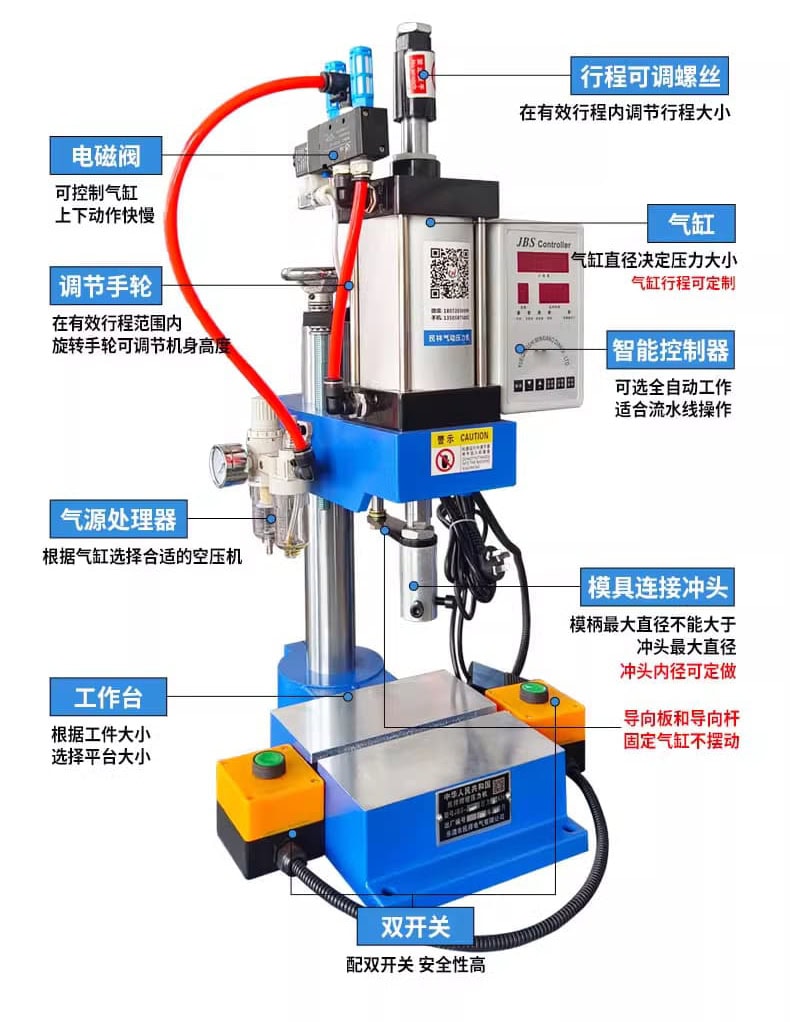Heat staking can result in weak joints if not executed properly, leading to poor product durability and failure. However, using the right heat staking machine ensures precision and reliable, strong joints for plastic parts.
Heat staking machines are devices used to join thermoplastic materials by melting and reshaping them with heat and pressure, creating permanent bonds. They offer precise control for consistent and strong joints, ideal for automotive, electronics, and medical industries.
This article will explore the working principles, materials, and applications of heat staking machines.

What Does a Heat Staking Machine Do?
Heat staking machines are designed to join thermoplastic parts by utilizing heat to melt and reshape plastic pegs, rivets, or bosses. These reshaped parts form a secure, permanent bond between components.
This method is widely used in industries such as automotive, electronics, and medical devices. A heat staking machine is essential in manufacturing processes where precision is required to ensure a strong, lasting bond. For example, in the flag labeling machine industry, thermoplastics are often used, and precise joining methods like heat staking are crucial for component integrity.
How Does Heat Staking Work?
The process of heat staking involves three critical steps: heating, forming, and cooling.
- Heating: A heated tool or tip makes contact with the plastic part, causing it to soften.
- Forming: The softened material is reshaped into the desired form, such as a rivet or peg, to secure the parts.
- Cooling: Once the part is formed, it cools and solidifies, resulting in a durable bond.
This method allows manufacturers to join dissimilar materials and achieve high levels of precision, making it ideal for delicate components.
Materials Used in Heat Staking
Heat staking is most commonly used with thermoplastic materials. These materials soften when heated, allowing them to be easily reshaped and bonded. Some of the most popular materials include:
- ABS (Acrylonitrile Butadiene Styrene)
- Polycarbonate
- Polypropylene
These thermoplastics offer durability, making them ideal for industries requiring precision and high strength. In applications such as bottle filling machines, these materials are crucial for the construction of durable components.
Differences Between Heat Staking and Ultrasonic Welding
Heat staking and ultrasonic welding are both popular methods for joining plastics, but they have significant differences.
- Heat Staking: This method applies direct heat to melt and reshape plastic, providing more control and precision, especially for smaller parts.
- Ultrasonic Welding: This method uses high-frequency vibrations to generate heat through friction. While faster, ultrasonic welding is less precise and can damage delicate components.
Heat staking is preferable when precision and the integrity of smaller parts are critical, such as in applications involving electronics or medical devices.
Best Practices for Heat Staking
Achieving optimal results with heat staking requires attention to several best practices:
- Temperature Control: Ensure the right temperature is used to avoid excessive melting or weak bonds.
- Tool Design: Properly designed tools ensure even heat distribution, which is essential for creating strong bonds.
- Cooling Time: Allow sufficient cooling time to ensure the bond fully sets and strengthens before handling.
These best practices apply to various industries, including the vacuum packaging machine industry, where precision bonding is crucial for product integrity.
Common Applications of Heat Staking Machines
Heat staking machines are used in a wide range of industries, including:
- Automotive: Heat staking is commonly used to assemble dashboard components, interior trims, and electronic housings.
- Electronics: It is utilized to secure components inside devices such as smartphones and laptops.
- Medical Devices: Heat staking is used to assemble plastic housings for medical instruments, ensuring a reliable and hygienic bond.
What Are the Limitations of Heat Staking?
Despite its advantages, heat staking does have some limitations. For instance:
- Inconsistent Heating: If heat is not evenly distributed, it can lead to weak joints, especially in larger parts.
- Slower Process: Compared to methods like ultrasonic welding, heat staking can be slower, particularly in high-volume production environments.
However, when precision and joint strength are paramount, heat staking remains the superior choice.
Heat Staking vs. Cold Staking
Cold staking is an alternative method that does not use heat. Instead, it relies on mechanical force to reshape and secure the parts. While it may be suitable for heat-sensitive materials, cold staking is generally less reliable for creating strong, durable bonds compared to heat staking.
Conclusion
Heat staking is an essential process for industries requiring strong, precise joints in thermoplastic materials. By following best practices and utilizing the right equipment, such as heat staking machines, manufacturers can ensure durable, high-quality bonds for a variety of applications.









